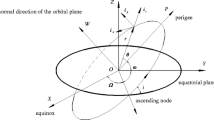Abstract
Dynamic equations of orbital elements of a modified vernal equinox for a far-distance cooperative rendezvous between two spacecraft were set up in this paper. The process of the far-distance cooperative rendezvous was optimized by a hybrid algorithm combining particle swarm optimization and differential evolution. The convergent costate vectors were obtained and set as the initial values of sequential quadratic programming to search for precise solutions, and the results proved to be stable and convergent. It can be seen from the results that the flight time of the cooperative rendezvous would be largely saved the amplitude of the thrust would be increased if the other conditions are fixed, and the fuel consumption would not be increased. However, the flight time would no longer decrease when the amplitude of the thrust reaches a certain value. In the last section of this paper, cooperative rendezvous and active–passive rendezvous were compared and analyzed, showing the advantages of cooperative rendezvous when the initial conditions are the same.


















Similar content being viewed by others
Abbreviations
- \(a\) :
-
Semi-major axis
- e :
-
Eccentricity
- \(i\) :
-
Orbit inclination angle
- \(I_{\text{sp}}\) :
-
Thruster-specific impulse
- \(J\) :
-
Performance index
- \(m_{0}\) :
-
Initial mass of the satellite
- \(m\) :
-
Mass of the satellite
- T :
-
Thrust
- \(R_{\text{e}}\) :
-
Equator radius
- \(u\) :
-
Ratio of the amplitude of the actual thrust relative to \(T_{\text{max} }\)
- \(\varvec{\alpha}\) :
-
Unit direction vector
- \(\beta\) :
-
Pitch angle
- \(\theta\) :
-
True anomaly
- \(\varvec{\varPhi}\) :
-
Shooting equation
- \(\gamma\) :
-
Yaw angle
- λ :
-
Costate
- μ :
-
Gravitational constant of the earth
- ω :
-
Perigee amplitude
- Ω :
-
Longitude ascending node
- g 0 :
-
Gravitational acceleration
References
Kechichian, J.A.: The optimization of continuous constant acceleration transfer trajectories in the presence of the J 2 perturbation. Astrodynamics 1999, 1627–1648 (2000)
Goodson, T.D.: Fuel-optimal Control and Guidance for Low-and Medium-Thrust Orbit Transfer. Georgia Institute of Technology, Atlanta (1995)
Chien-Hsiung, C., Speyer, J.L.: Periodic optimal hypersonic scramjet cruise. Optim. Control Appl. Methods 8(3), 1403–1408 (1985)
C-Hgoodson, C., Troy, D., Ledsinger, L., Hanson, J.: The second variation and neighboring optimal feedback guidance for multiple burn orbit transfers. In: Guidance, Navigation, and Control Conference (1995)
Betts, J.T., Erb, S.O.: Optimal low thrust trajectories to the moon. SIAM J. Appl. Dyn. Syst. 2(2), 144–170 (2003)
Betts, J.T.: Very low-thrust trajectory optimization using a direct SQP method. J. Comput. Appl. Math. 120(s 1–s 2), 27–40 (2000)
Herman, A.L., Spencer, D.B.: Optimal, low-thrust earth-orbit transfers using higher-order collocation methods. J. Guid. Control Dyn. 25(1), 40–47 (2002)
Armellin, R., Topputo, F.: A sixth-order accurate scheme for solving two-point boundary value problems in astrodynamics. Celest. Mech. Dyn. Astron. 96(3), 289–309 (2006)
Zavoli, A., Colasurdo, G.: Indirect optimization of finite-thrust cooperative rendezvous. J. Guid. Control Dyn. 38(2), 304–314 (2015)
Zhu, R.Z.: Rendezvous and docking techniques of spacecraft [M]. National Defense Industry Press, Beijing (2007)
Prussing, J.E., Conway, B.A.: Optimal terminal maneuver for a cooperative impulsive rendezvous. J. Guid. Control Dyn. 12(3), 433–435 (1971)
Mirfakhraie, K.: Optimal cooperative time-fixed impulsive rendezvous. J. Guid. Control Dyn. 17(3), 757–770 (1988)
Crispin, Y., Seo, D.: Rendezvous between two active spacecraft with continuous low thrust. In Tech (2011)
Feng, W.M., Ren, F., Shi, L., Feng, W.M., Ren, F., Shi, L.: Optimal control for far-distance rapid cooperative rendezvous. Proc. Inst. Mech. Eng. Part G J. Aerosp. Eng. 228(14), 2662–2673 (2014)
Feng, W., Han, L., Shi, L., Zhao, D., Yang, K.: Optimal control for a cooperative rendezvous between two spacecraft from determined orbits. J. Astronaut. Sci. 63(1), 23–46 (2016)
Bate, R.R., Mueller, D.D., White, J.E.: Fundamentals of Astrodynamics. Progress Publishers, Mascow (1971)
Pontani, M., Conway, B.A.: Particle swarm optimization applied to space trajectories. J. Guid. Control Dyn. 33(5), 1429–1441 (2010)
Storn, R., Price, K.: Differential evolution—a simple and efficient heuristic for global optimization over continuous spaces. J. Glob. Optim. 11(4), 341–359 (2010)
Das, S., Abraham, A., Konar, A.: Particle swarm optimization and differential evolution algorithms: technical analysis, applications and hybridization perspectives. Int. J. Comput. Intell. Stud. 116, 1–38 (2008)
Betts, J.T.: Using sparse nonlinear programming to compute low thrust orbit transfers. J. Astronaut. Sci. 41(3), 349–371 (1993)
Herman, A.L., Conway, B.A.: Direct optimization using collocation based on high-order Gauss–Lobatto quadrature rules. J. Guid. Control Dyn. 19(3), 592–599 (1996)
Sun, J.W., Qiao, D., Cui, P.Y.: Study on the optimal trajectories of lunar soft-landing with fixed-thrust using SQP method. J. Astronaut. 1, 021 (2006)
Author information
Authors and Affiliations
Corresponding author
Rights and permissions
About this article
Cite this article
Feng, W., Wang, B., Yang, K. et al. Cooperative rendezvous between two spacecraft under finite thrust. CEAS Space J 9, 227–241 (2017). https://doi.org/10.1007/s12567-017-0145-9
Received:
Revised:
Accepted:
Published:
Issue Date:
DOI: https://doi.org/10.1007/s12567-017-0145-9




